Different research shows that ICTs reach an increasing number of people and that the time we spend throughout the day increases (IAB, 2021; We are social, 2021, AIMC, 2021; Barlovento Comunicación, 2022; Médiamètrie, 2021). It is increasingly important to have a device connected to the network to work, spend time, communicate or receive information.
In this context, it is becoming increasingly difficult to distinguish the spaces defined by ICT from the times and destinations of electronic instruments. The public and private, work and leisure spaces and the mobiles we use in all of them, laptops, tablets or smart televisions are very present in our daily lives.
In any case, despite being common artifacts, three social functions prevail: communicating with colleagues, informing and feeling entertained. As mentioned above, the computer equipment and means we use for these three tasks are mixed, but a certain specialization is appreciated. More use is made of social communication networks and instant messaging via mobiles. You still prefer television and its big screen to channel information. And finally, they are dedicated to so-called entertainment, on the one hand, television itself with live content, on the other, social networks with short videos and, finally, uptake of fiction, digital platforms.
In this article we will talk about the latter because in people’s everyday life fiction occupies an important place, especially among the youngest, and because it also explains what content they like, when and where they see it, and above all how they discover those fictional content in a vast audiovisual catalog so prolific. In this paper we will look at the consumption behaviors of the young people of Araba, Bizkaia, Gipuzkoa and Navarra, analyzing the responses of the surveys we have sent to the members of the Ikusiker Panel, created for this purpose. Among these young people aged 11 to 23, we will talk about the importance of fiction content and the spectacularity of different products.
Last seen content
As pointed out in the introduction, the presence of audiovisual media is currently particularly high among young people. We have sought to delve into the nature and behaviour of the consumption of these products through a number of consultations. First, the students of the UPV/EHU and the UPNA that make up the Ikusiker Panel in early 2021 (1) were asked if there were any entertainment, information or fiction content among the videos, programs or stories observed in recent days. The answers show that these university students are easily imaginable with the intention of entertaining, being informed or enjoying fictional content. As shown in this first figure, there are other types of content, but most young people remember these three contents more clearly.
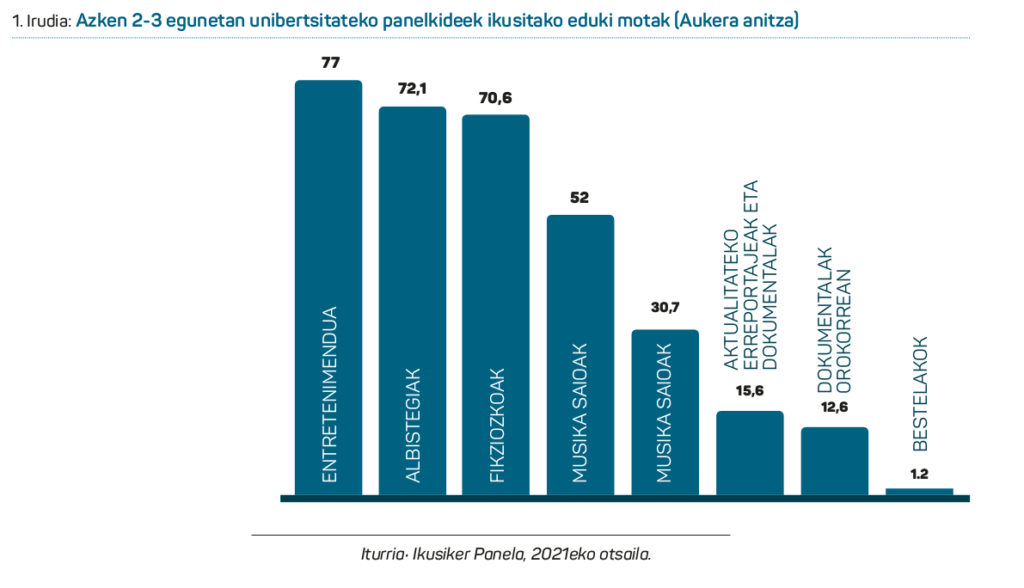
On the other hand, we ask them to concretize the audiovisual consumptions carried out by young people between 18 and 23 years of age and the platforms, channels or suppliers they like the most. Of the responses obtained in the surveys, the three most cited are: Paid Youtube, Instagram and VoD platforms, including Netflix. Behind these three major systems is linear television with 27.2% of students, compared to traditional television services A la Carta (13.2%), as the second figure shows.
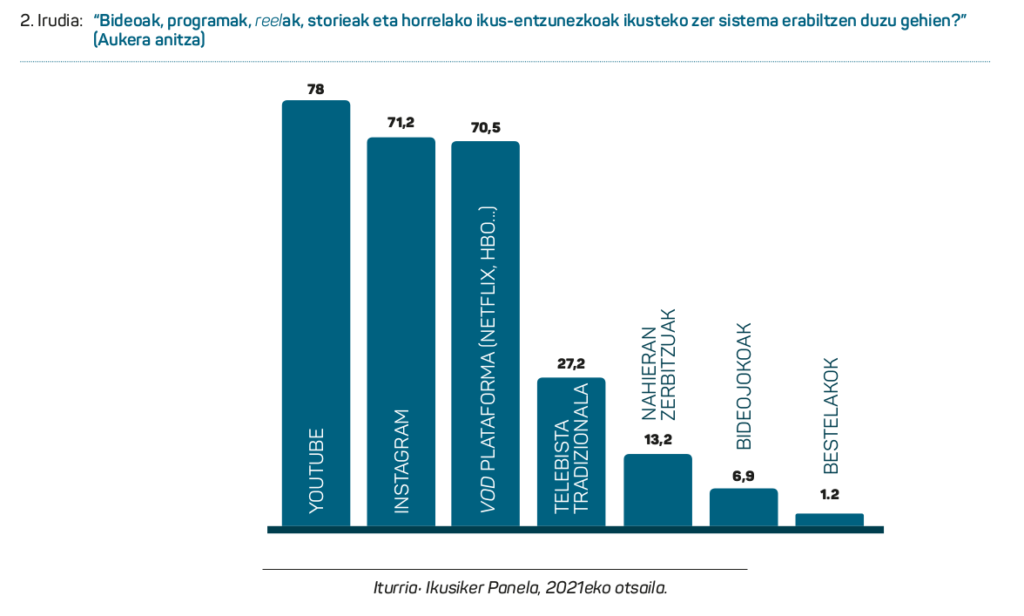
Predominance of fictitious content
Having seen the weight of fiction (series are the ones that most like and follow) and the importance of digital payment platforms in channeling these consumptions, we found it interesting to know how they have reached those contents. That is, the prosperity of the audiovisual market, why and how some series are chosen and not others. To do so, in the surveys we have asked them to show their degree of conformity with some phrases.
The question we have asked is: "Why do you see the series? Please tell me how far you agree with the following phrases:
- My friends see them and I also see them recommended.
- On social media, I understand what are the most interesting and I see them.
- I see what the digital platforms themselves (Netflix, Amazon…) are proposing to me. "
The results of the following images show that three factors positively influence the decision on what they will see, and this is indicated, respectively, by 53.9%, 50% and 595% of respondents (we collect the answers “fully agree” and “slightly agree”). Just over a quarter of it is not clear to what extent the thrust of friends, social networks or algorithms feels when marking their consumption. Clearly, the number of those who do not identify is much lower.
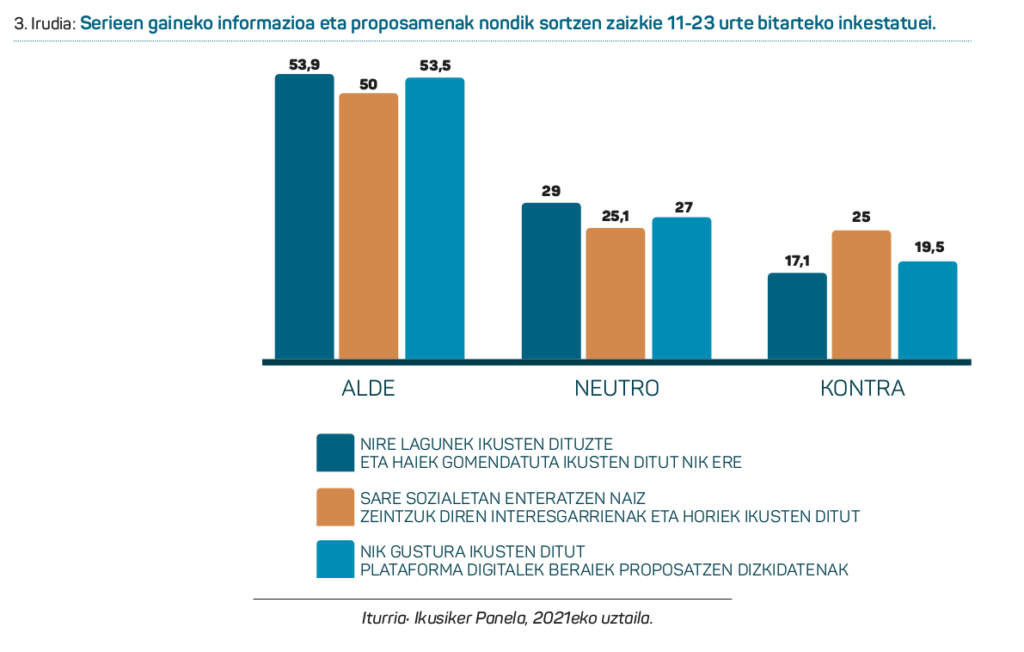
Therefore, just over half of the young people have defined these three information or sources of proposals as factors that influence their consumption.
In any case, depending on age, differences can be observed among gang members when identifying friends, social networks and algorithms as determinants of their consumption.
For example, among the youngest respondents (11 to 17 years old), opinions about the influence of social media and friends are somewhat more modest and more marked by the more personalized proposals that automatically make Netflix, HBO or Amazon Prime Video.
As can be seen in the following two figures, among the students of the UPNA and the UPV/EHU, and from the responses of the Panelkides from 18 to 23 years old, it can be affirmed that dating and comments on social networks more clearly influence serial fiction consumption.
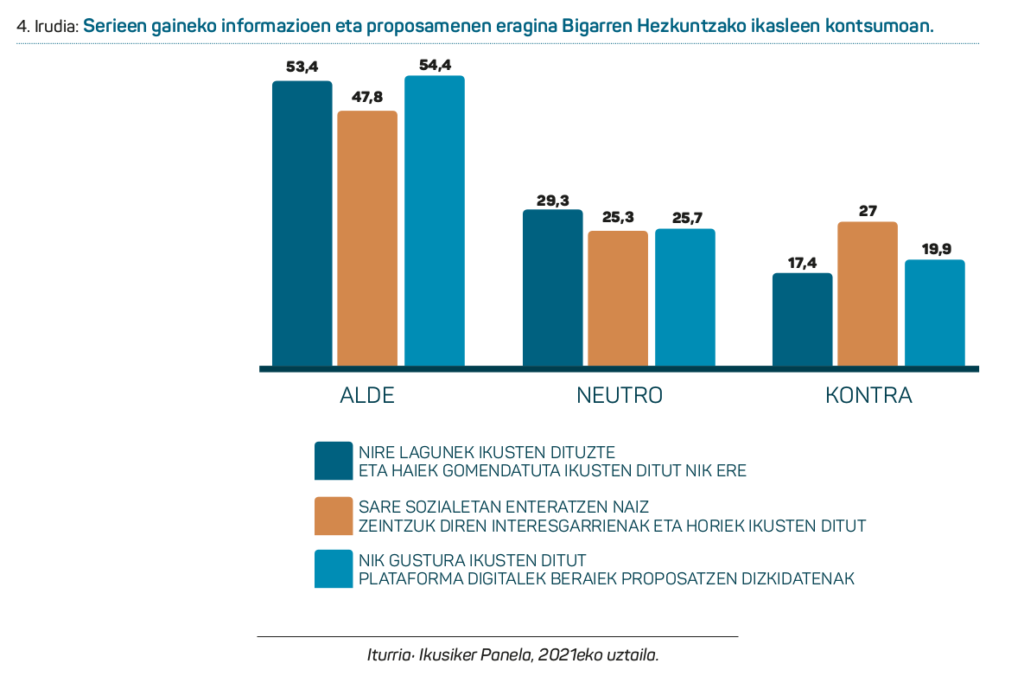
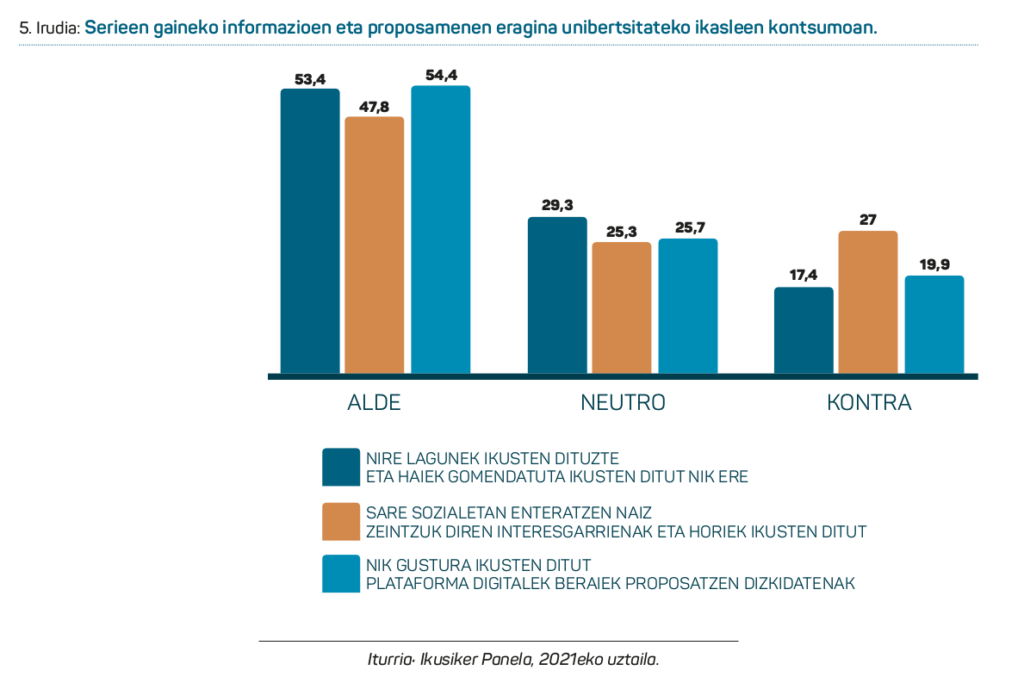
Therefore, what series do the young people of Hego Euskal Herria see, either for being mentioned on social networks, on an automated proposal of the VoD platform from their respective historical consumption, or on the recommendation of their friends? And in general, what is that consumption like?
Information on these and other questions will be developed in the following passages, taking advantage of data from surveys conducted during the course 2020-2021.
To begin with, we will remember that the series are highly defined fictitious products, with durations usually less than an hour and very often sections (of course it must be limited to 6 chapters). The evolution of the series has been remarkable in the last decade since the quantitative and qualitative leap from linear television to payment services. Despite the different themes, group-purpose, type of production, origin, narrative and success, the series today constitute the basis of audiovisual consumption.
To measure the success of the different series, first of all, the young people surveyed have been asked to freely say what their favorite productions are. We have then been able to delve into the scope of the series that mention most of this group of names filled with the names they have said.
Figure 6 shows the measure of success, as it shows the numbers of high school and university students who have seen the most famous series. The fact is clear: just over half of the young people have seen the top four on the list: The paper house, Elite, Stranger things and Sex education. This larger range quartet is followed by a long line with lower-range series titles. When assessing the most dispersed series, it is not bad to remember that the international catalogue of audio-visual available to our young people is very wide.
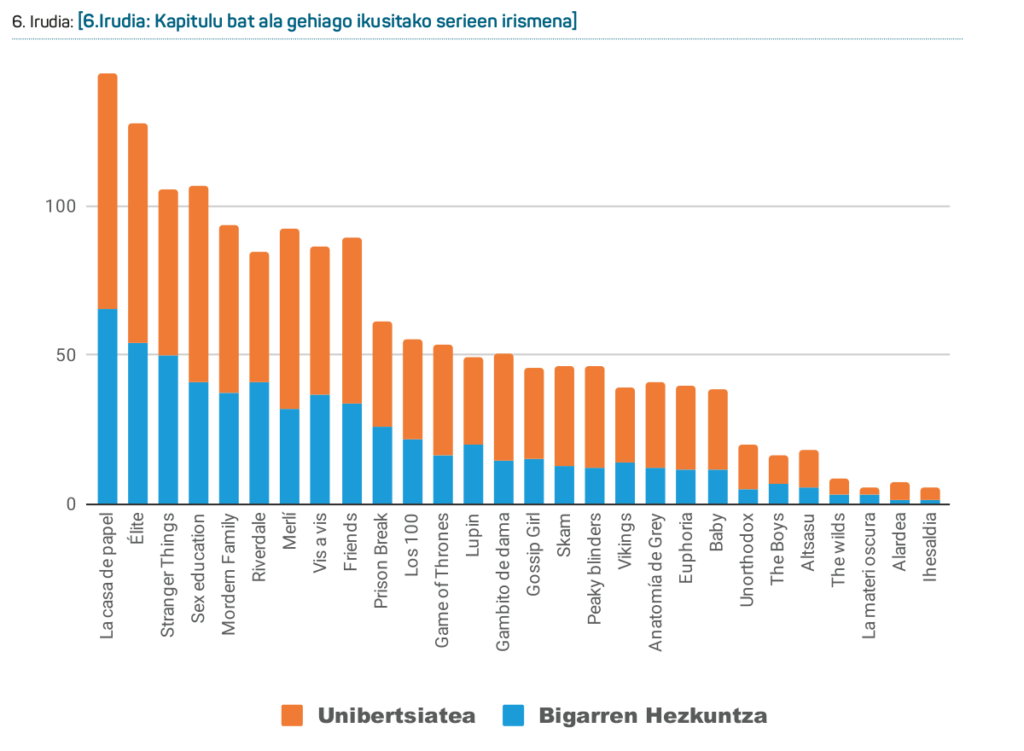
Delving into the consumption behavior of high school and college students, and speaking of serial fiction, we asked them on which platform they have seen the final product observed, with which devices, at what time of the day and, in general, what valuation they make of the last series of views. These three questions help us complete the consumer ecosystem of the series and provide more detailed information on audiovisual products that have become so popular.
In the answers to the first question you can see that three out of four students have seen through the digital platforms this last series they remember. To this should be added 10% more than you have seen through free websites and about 5% of what you have seen through social networks. Therefore, the natural environment in the consumption of the series are VoD services, being very modest the one mentioned by television. If linear television and television are added via Nahieran services, the percentages are not very high (8.5% for IP and 6.7% for university).
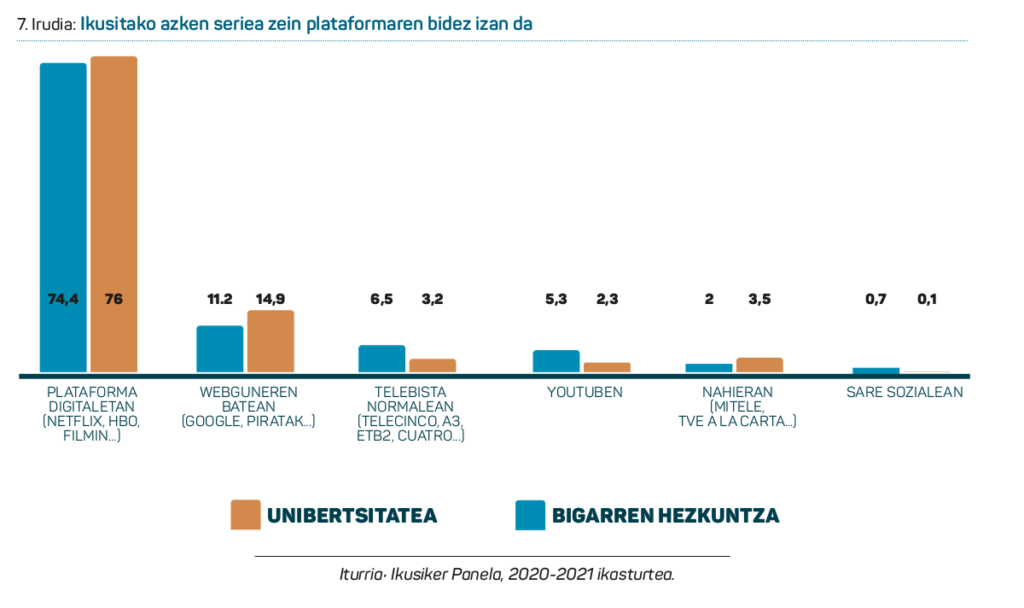
The figure above shows the weight of the online suppliers and specifies the most used visualization devices somewhat below. Here it is interesting to note that the lifestyle and hobbies of ESO students (11-17 years) and university students (18-23 years) are different, and this is reflected in the schedule, electronic equipment and tastes and, in general, in the consumption of these serial audiovisual products.
For example, when we asked them to specify what the electronic device used to view the last series is, in the case of ESO students almost double what they have seen on ordinary television. In contrast, among university students, 44% of laptop users. The figures tend to be homogenised as regards the lower use of other appliances. Perhaps it is worth noting that the number of people who mention the mobile phone to watch the series is limited, with 17.6% of ESO students and 13.1% of university students.
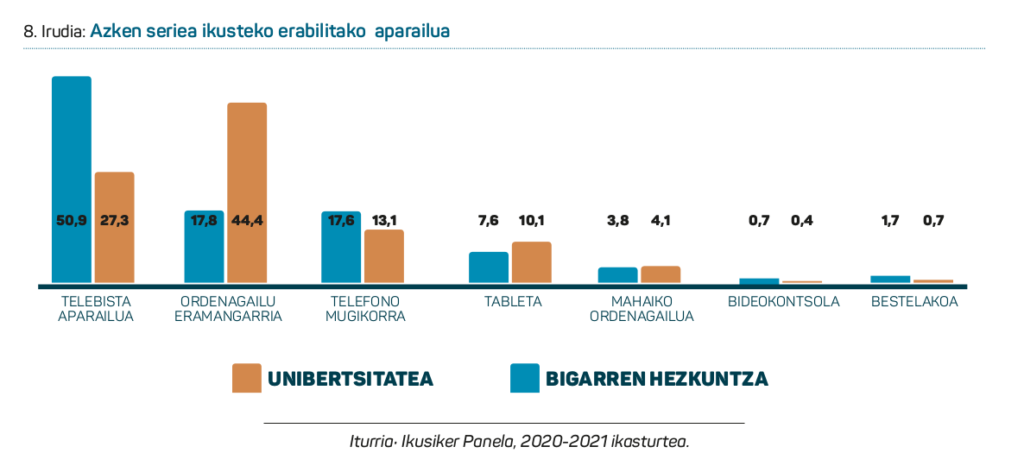
The following figure also illustrates the time of the day when you saw the last selected series. It is observed that the prime time of these series is the night, especially among university students (66.7% of the answers indicate darkening hours). In any case, it is noteworthy that the afternoon is very common in the groups of two years to see series, as the average number of people who have seen the last series in the afternoon is around fifty.
In addition, when we asked them if they have different times to see the series between week and weekend, the answers indicate that on weekends they prefer each other, around 80% of the cases.
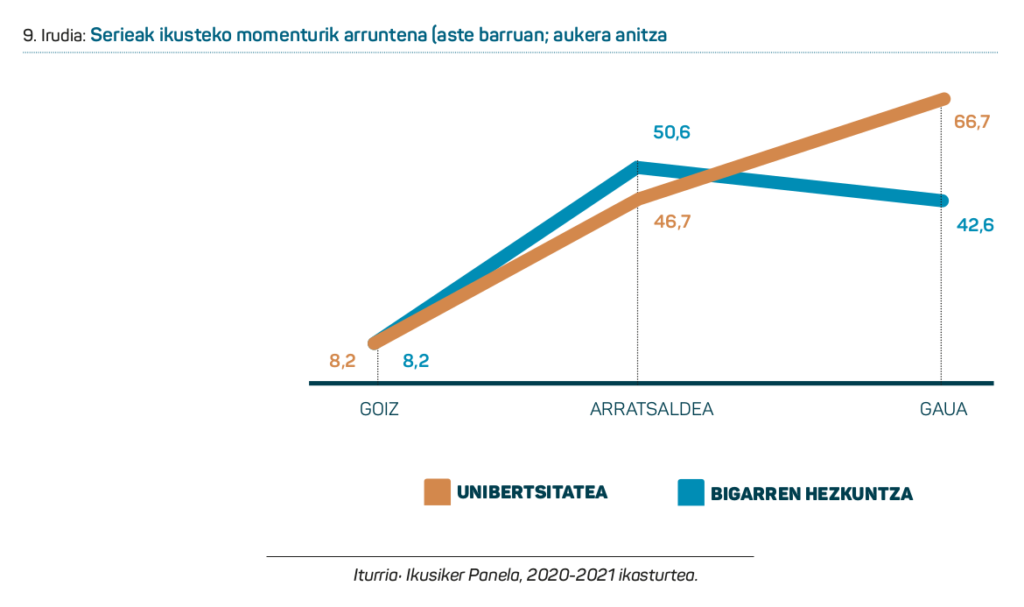
Finally, and as we have already reviewed the most common behaviors that occur in the consumption of series, always taking as reference the last one they have seen, we have asked them to evaluate this series with another question. Through the series that each one has seen, we have somehow wanted to know what satisfaction with this genre is. On a scale from zero to five, the work we"ve given you has been to take note of the last sight series. Some difference in the level was observed in the answers. The youngest give them the highest grade (5) and, according to the university students, the grades they have seen, in their positivity, but are between 4 and 5 in five.
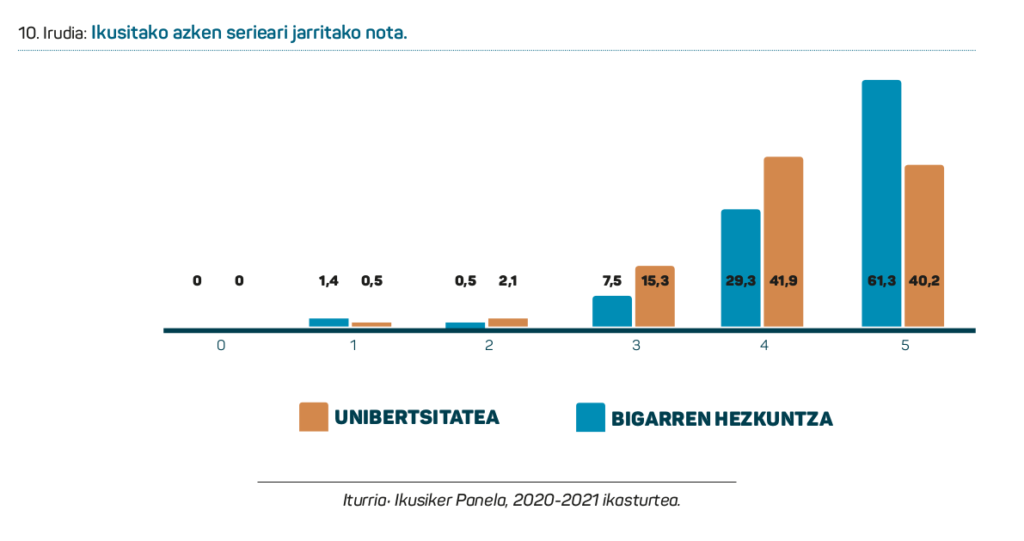
Among the series mentioned, the number of Basque and Basque productions is very low. In general, the fictional and audiovisual audio-visual languages of which they are successful, the duplicity of these languages and the most accurate data on the use of subtitles can be found in other research carried out in the Ikusiker Panel (Panel Ikusiker, 2020).
Paying attention to the various EITB productions
The previous sections of this article explain the role of fiction in the consumption of students in the Ikusiker Panel and the place, time and apparatus by which these young people see the series they like. We have mentioned with one title several productions that have been very successful, of which we have said that very few are produced in the Basque Country. In addition, through the responses obtained from the surveys, it has been emphasized that the consumption of young people on social networks is influenced by the reading of the series by the students, by the proposals of the algorithms or by the recommendations of the friends.
From now on we will look for signs of a relationship between previous knowledge of the series, the dissemination system used to reach the public and consumption. To do so, we will analyze four specific productions of EITB and we will rely on the opinions of several students of the UPV/EHU rather than their statistical significance, assuming that it can be interesting to mark trends.
The fiction programmes “AIDS”, “Euria ari du”, “Daniel(a)” and “Irabarte” offered by EITB between 2019 and 2021 will be considered. With the collaboration of the members of the different undergraduate and master"s classrooms of the Faculty of Social Sciences and Communication of the UPV/EHU we have been able to obtain information about these productions through specific surveys. As we have already said, we have been particularly interested in knowing whether they were aware of these productions and in determining what would be the most appropriate broadcasting system for these audiovisual productions.
In the case of the four fiction series, the number of communication students who knew it was very small in the survey conducted shortly after its release. From this level of ignorance, logically, the percentage of those who saw it at the time of the study was even lower.
Limiting ourselves to the case of the web section of six sections “Daniel(a)” (2021), two weeks after the premiere of the production we survey undergraduate and master in communication students. The number of people who had seen the production of fiction in Basque, produced exclusively for online media, was virtually zero. Similarly, only 17% and 24% of those who had known or had heard of the “Daniel(a)” series were undergraduate and master students respectively.
In EITB’s production surveys on “Evasion” (2019), “Euria ari da” (2020) and “Irabarte” (2021), UPV/EHU students stated that it was not common to use linear television to watch fiction. For these young people, the most appropriate broadcast systems like these are VoD platforms, Youtube, social networks and Charter services. The following figure shows the percentage of undergraduate and master"s students who consider the most appropriate dissemination systems for these products.
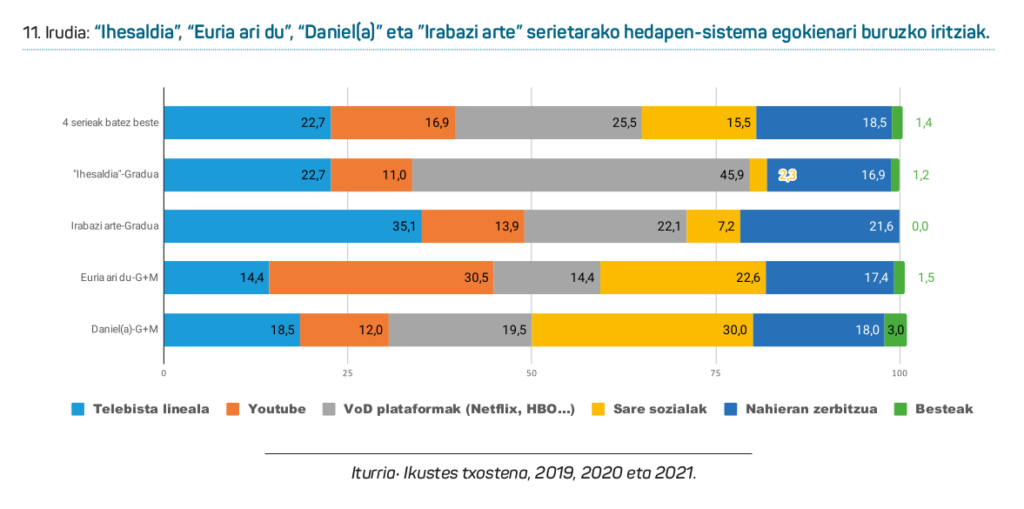
The first indent of Figure 11 shows that 77.3 percent of university students surveyed see fiction programs like these outside traditional television. The preferred distribution system is the digital platform (25.5%), ahead of Nahieran (18.5%), Youtube (16.9%) and social networks (15.5%).
To end this section, and following the above arguments, we will answer a final question in the production study “Daniel(a)”. As we have said, prior information from this series of webseries on transsexuality was very scarce for the 60 university students surveyed and very low for those who had seen some section. After an act of presentation with these young people studying communication from the UPV/EHU (we gathered about sixty students who study Basque and Spanish, on the campus of Leioa, at the end of November 2021, with the writer and filmmaker, explaining the fiction program and the decreases in production), it was important that they went to the website as the different sections of the series at home.
As shown in the last figure of the article, 38% of the students who participated in the experiment only saw the first section, but 41% did the sixth. These two data demonstrate not only the importance of knowing a production and differentiating it from the immense catalogue of series available to young people, but, once this isolation has been achieved, adherence and the number of sections observed as a result is high. It should also be taken into account that the audiovisual product selected for this study, carried out as an exercise, could only be seen in the network, so it was more common for students.
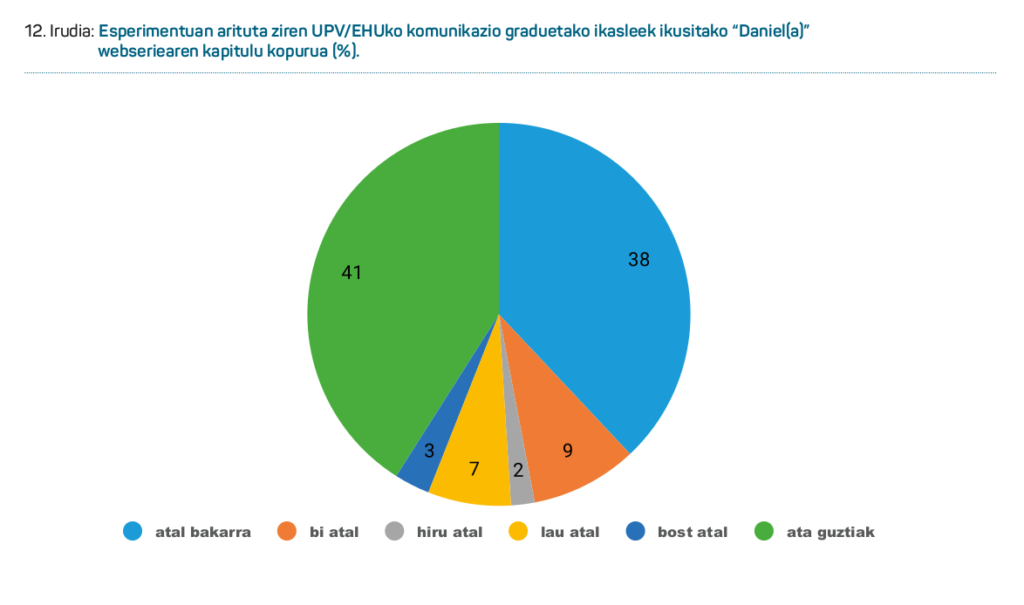
The importance of visibility
Different studies show that the audience of audiovisual products produced in the Basque Country is low among young people, and even lower that of products in Euskera, especially in the series, films and programs that are disseminated on online platforms. The problem is complex, conditioned by a multiplicity of factors and requires deep reflection.
In this article, based on the data extracted from the research Ikusiker Panela and Ikusest (Laboratory of Audiovisual Testing), we wanted to highlight the idea that, firstly, the online media and media used by young people mark their audiovisual playing field and, secondly, in the immense catalog of available series, films or videos, that the products here have little visibility.
The audiovisual consumption of young people is high, especially in online platforms and media. In general, closed programming television has lost its importance and, except for direct or occasional television, it hardly occupies any space in its daily lives.
They use ICT for three purposes or tasks: communicating with each other, being informed and spending time. For this last social function fiction occupies an important place.
The students of Araba, Bizkaia, Gipuzkoa and Navarra, belonging to the Ikusiker Panel, show their free practice through the immense international catalog. They use the resources of social networks, digital platforms and, in general, olines at their disposal. They consume audiovisual products in pil-pil, enjoying products in different origins, contents and languages.
When deciding what is to be chosen and what is to be seen in an apparently unlimited offer, as we have explained in this article, young people take into account the recommendations of their friends, the proposals of the digital platforms and those they hear on social networks. There is, therefore, the second key that audiovisual products must address here: making these contents visible. The evaluations of the different products analyzed in the laboratory Ikusi est show that they are similar to others that exist in the market but do not reach the general public. That is, that, among other things, the themes, characters or rhythms of these audiovisuals are comparable but do not manage to reach the public. The intensity of international productions casts a shadow on them. That is undoubtedly the great challenge. Properly define and manage the factors that will function as distinctive. To this end, it is necessary to develop and implement the Basque audiovisual mark. In fact, the experiments that have been conducted among students show that the number of people who see, like, and engage once a product is known is not small.
Bibliography
AIMC (2021):23 Sailors on the 2021 network. Ikusentzunezkoak: https://www.aimc.es/π-obras/navegantes -la-red/
AIMC (2021): General media framework in Spain 2021. Visual: https://www.aimc.es/others.studies -jobs/container -general/downloading -marco -general/
Arana Arrieta, E. et al. (2021): “The virus struck audiovisual consumption among young people”, 77-92, in Libe Mimenza (eds.) Basque Media Yearbook. Leioa: Observatory.
Barlovento Communication (2022): 2021 Analysis of the audiovisual television industry. Visible: https://www.barloventocomunicacion.es/audi annual/2021-analysis -of-la-industrial -televisi-audiovisual/
BIA (2021): Annual online video study 2021. Visible: https://iabpain.es/estudio/carreras -\-de-video-onlin-2021/
audiovisual consumption and the use of ICT". Panel Report Ikusiker University. July 2021. Applika research project (US20/21). UPV/EHU http://ikusiker.eus
Panel Ikusiker (2020): “Entertainment content and seen languages”). 15. Report. December 2020. Applika research project (US20/21). UPV/EHU http://ikusiker.eus
Panel Ikusiker (2021): “High school and university students
Panel Ikusiker (2021): “Series consumption”...18 of the Ikusiker Unibertsitatea Panel. Report. February 2021. Applika research project (US20/21). UPV/EHU http://ikusiker.eus
Mediametrie (2021): L’audience de la télévision en 2021. Visible: https://www.mediametrie .fr/fr/laudi
We are social (2021): Digital 2021. Global overview report. Visible: https://datareportal.com/reports/digital-2021-amun-overview-report
SUMMARY OF PRODUCT CHARACTERISTICS
The research project of Applika+ (US20/21), in which the UPV/EHU, Tabakalera, EITB and the Basque Observatory of Culture collaborate. It contains different lines of work, two of which are cited in this article: Laboratory to test the Ikusiker Panel and the Audiovisual. The Ikusiker Panel aims to analyze audiovisual consumption and the use of Information and Communication Technologies (ICT) of youth in the Autonomous Community of the Basque Country and Navarre. The panel consists of high school (ESO) and university students from these two autonomous communities. The first includes those between 11 and 17 years of age, and the second includes those between 18 and 23 years of age. The average number of young people participating in research is that of young people. Surveys are conducted via the platform www.pollestafacil.com.
More information about the Ikusiker Panel can be found at www.ikusiker.eus


